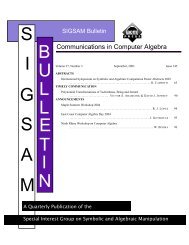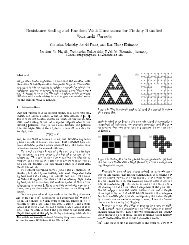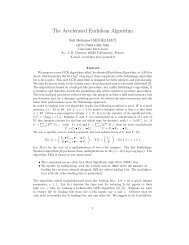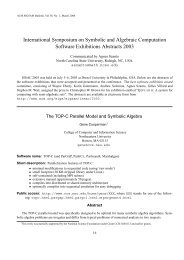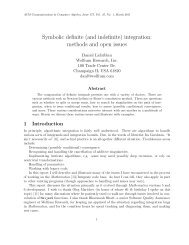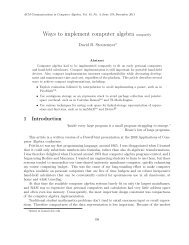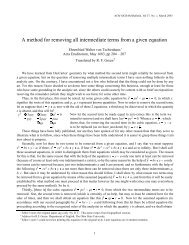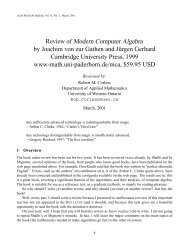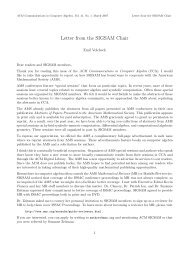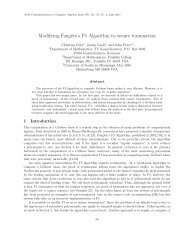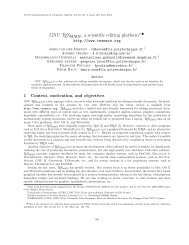Abstracts of the CADO workshop on integer factorization - SIGSAM
Abstracts of the CADO workshop on integer factorization - SIGSAM
Abstracts of the CADO workshop on integer factorization - SIGSAM
You also want an ePaper? Increase the reach of your titles
YUMPU automatically turns print PDFs into web optimized ePapers that Google loves.
ACM Communicati<strong>on</strong>s in Computer Algebra, Vol. 43, No. 1, March 2009<br />
<str<strong>on</strong>g>CADO</str<strong>on</strong>g> Workshop <str<strong>on</strong>g>Abstracts</str<strong>on</strong>g><br />
<str<strong>on</strong>g>Abstracts</str<strong>on</strong>g> <str<strong>on</strong>g>of</str<strong>on</strong>g> <str<strong>on</strong>g>the</str<strong>on</strong>g> <str<strong>on</strong>g>CADO</str<strong>on</strong>g> <str<strong>on</strong>g>workshop</str<strong>on</strong>g> <strong>on</strong> <strong>integer</strong> factorizati<strong>on</strong><br />
Communicated by Emmanuel Thomé<br />
INRIA Lorraine<br />
http://www.loria.fr/~thome/<br />
Emmanuel.Thomeatnormalesup.org<br />
The <str<strong>on</strong>g>CADO</str<strong>on</strong>g> <str<strong>on</strong>g>workshop</str<strong>on</strong>g> <strong>on</strong> <strong>integer</strong> factorizati<strong>on</strong> was held in Nancy, France, <strong>on</strong> October 7-9th, 2008.<br />
The <str<strong>on</strong>g>workshop</str<strong>on</strong>g> was focused <strong>on</strong> <str<strong>on</strong>g>the</str<strong>on</strong>g> Number Field Sieve and its implementati<strong>on</strong> aspects. Fifty participants<br />
attended <str<strong>on</strong>g>the</str<strong>on</strong>g> <str<strong>on</strong>g>workshop</str<strong>on</strong>g>.<br />
The <str<strong>on</strong>g>workshop</str<strong>on</strong>g> was organized by Pierrick Gaudry, Emmanuel Thomé and Paul Zimmermann.<br />
Slides from talks can be downloaded from http://cado.gforge.inria.fr/<str<strong>on</strong>g>workshop</str<strong>on</strong>g>/<br />
<str<strong>on</strong>g>Abstracts</str<strong>on</strong>g> <str<strong>on</strong>g>of</str<strong>on</strong>g> invited talks<br />
Numbers related to NFS<br />
Kazumaro Aoki, NTT, Tokyo, Japan.<br />
NFS requires a large amount <str<strong>on</strong>g>of</str<strong>on</strong>g> parameters. Though <str<strong>on</strong>g>the</str<strong>on</strong>g> order <str<strong>on</strong>g>of</str<strong>on</strong>g> <str<strong>on</strong>g>the</str<strong>on</strong>g> parameters is known, setting<br />
optimal values requires some art. Not much data from large <strong>integer</strong> factorizati<strong>on</strong>s is available,<br />
however experimentalists are helped a lot by seeing <str<strong>on</strong>g>the</str<strong>on</strong>g> numbers. I provide as detailed figures as I<br />
have, including <str<strong>on</strong>g>the</str<strong>on</strong>g> following topics : 1. experimental results generated from factorizati<strong>on</strong> <str<strong>on</strong>g>of</str<strong>on</strong>g> c176 in<br />
11,281+, 2. Mixed special-Q usage <str<strong>on</strong>g>of</str<strong>on</strong>g> algebraic side and rati<strong>on</strong>al side, 3. Experiences <str<strong>on</strong>g>of</str<strong>on</strong>g> hardware<br />
failures in l<strong>on</strong>g term factorizati<strong>on</strong>, 4. R311 ECM.<br />
Predicting NFS time<br />
Daniel J. Bernstein, University <str<strong>on</strong>g>of</str<strong>on</strong>g> Illinois, Chicago, USA.<br />
The time T (n, f, y 1 , . . .) used by NFS depends not <strong>on</strong>ly <strong>on</strong> <str<strong>on</strong>g>the</str<strong>on</strong>g> <strong>integer</strong> n to be factored but also <strong>on</strong><br />
various parameters chosen by <str<strong>on</strong>g>the</str<strong>on</strong>g> NFS user, such as a polynomial f, an initial smoothness bound<br />
y 1 , etc. One can accurately compute T (n, f, y 1 , . . .) by running NFS, but <str<strong>on</strong>g>of</str<strong>on</strong>g> course this is ra<str<strong>on</strong>g>the</str<strong>on</strong>g>r<br />
slow, especially if <strong>on</strong>e wants to compute several values <str<strong>on</strong>g>of</str<strong>on</strong>g> this functi<strong>on</strong> T . I’ll discuss <str<strong>on</strong>g>the</str<strong>on</strong>g> speed and<br />
accuracy <str<strong>on</strong>g>of</str<strong>on</strong>g> various approximati<strong>on</strong>s to T .<br />
11
<str<strong>on</strong>g>CADO</str<strong>on</strong>g> Workshop <str<strong>on</strong>g>Abstracts</str<strong>on</strong>g><br />
<str<strong>on</strong>g>CADO</str<strong>on</strong>g> Workshop <str<strong>on</strong>g>Abstracts</str<strong>on</strong>g><br />
Polynomial selecti<strong>on</strong><br />
Thorsten Kleinjung, École polytechnique Fédérale de Lausanne, Switzerland.<br />
This talk will describe some tricks for polynomial selecti<strong>on</strong> for GNFS. An analysis and some results<br />
will also be given.<br />
Discrete Logarithms and Galois Invariant Smoothness Basis<br />
Reynald Lercier, Centre d’éléctr<strong>on</strong>ique de l’armement, Bruz, France.<br />
The difficulty <str<strong>on</strong>g>of</str<strong>on</strong>g> computing discrete logarithms in <str<strong>on</strong>g>the</str<strong>on</strong>g> multiplicative group <str<strong>on</strong>g>of</str<strong>on</strong>g> finite fields GF(q)<br />
with <str<strong>on</strong>g>the</str<strong>on</strong>g> functi<strong>on</strong> field sieve relies mostly <strong>on</strong> <str<strong>on</strong>g>the</str<strong>on</strong>g> ability <str<strong>on</strong>g>of</str<strong>on</strong>g> finding relati<strong>on</strong>s between elements <str<strong>on</strong>g>of</str<strong>on</strong>g><br />
a smoothness basis. We noticed in <str<strong>on</strong>g>the</str<strong>on</strong>g> past that in some very particularly cases (Kummer and<br />
Artin-Schreier <str<strong>on</strong>g>the</str<strong>on</strong>g>ories), <str<strong>on</strong>g>the</str<strong>on</strong>g> factor basis can be c<strong>on</strong>structed in such a way that it is left invariant<br />
by automorphisms <str<strong>on</strong>g>of</str<strong>on</strong>g> GF(q). This significantly accelerates discrete logarithm computati<strong>on</strong>s since<br />
it turns out that in such cases <str<strong>on</strong>g>the</str<strong>on</strong>g> dimensi<strong>on</strong>s <str<strong>on</strong>g>of</str<strong>on</strong>g> <str<strong>on</strong>g>the</str<strong>on</strong>g> linear system to be solved at <str<strong>on</strong>g>the</str<strong>on</strong>g> end <str<strong>on</strong>g>of</str<strong>on</strong>g> <str<strong>on</strong>g>the</str<strong>on</strong>g><br />
computati<strong>on</strong> is much smaller. In this talk, we are going to explain how this nice property can be<br />
generalized to a broad class <str<strong>on</strong>g>of</str<strong>on</strong>g> finite fields. (joint work with J.-M. Couveignes)<br />
Preliminary Design <str<strong>on</strong>g>of</str<strong>on</strong>g> Post-Sieving Processing for RSA-768<br />
Peter L. M<strong>on</strong>tgomery, Micros<str<strong>on</strong>g>of</str<strong>on</strong>g>t Research, USA.<br />
The security <str<strong>on</strong>g>of</str<strong>on</strong>g> <str<strong>on</strong>g>the</str<strong>on</strong>g> RSA cryptosystem relies <strong>on</strong> <str<strong>on</strong>g>the</str<strong>on</strong>g> believed difficulty <str<strong>on</strong>g>of</str<strong>on</strong>g> factoring large composite<br />
<strong>integer</strong>s. About eight sites are attempting to factor RSA-768, a 768-bit challenge number. The best<br />
known algorithm is <str<strong>on</strong>g>the</str<strong>on</strong>g> Number Field Sieve, whose current record is 663 bits. Existing s<str<strong>on</strong>g>of</str<strong>on</strong>g>tware<br />
needs upgrades to 64-bit manycore systems. I will describe some proposed algorithmic adjustments<br />
as we work to meet this challenge <strong>on</strong> state-<str<strong>on</strong>g>of</str<strong>on</strong>g>-<str<strong>on</strong>g>the</str<strong>on</strong>g>-art hardware.<br />
A Self-Tuning Filtering Implementati<strong>on</strong> for <str<strong>on</strong>g>the</str<strong>on</strong>g> Number Field Sieve<br />
Jas<strong>on</strong> S. Papadopoulos, ViaSat Inc, USA.<br />
This talk will describe <str<strong>on</strong>g>the</str<strong>on</strong>g> NFS filtering module <str<strong>on</strong>g>of</str<strong>on</strong>g> Msieve, an <strong>integer</strong> factorizati<strong>on</strong> library that has<br />
helped complete some <str<strong>on</strong>g>of</str<strong>on</strong>g> <str<strong>on</strong>g>the</str<strong>on</strong>g> largest public factorizati<strong>on</strong>s. This module performs <str<strong>on</strong>g>the</str<strong>on</strong>g> task <str<strong>on</strong>g>of</str<strong>on</strong>g> building<br />
a linear algebra problem from <str<strong>on</strong>g>the</str<strong>on</strong>g> collecti<strong>on</strong> <str<strong>on</strong>g>of</str<strong>on</strong>g> relati<strong>on</strong>s produced by NFS sieving. NFS filtering is<br />
highly memory-intensive, and <str<strong>on</strong>g>the</str<strong>on</strong>g> quality <str<strong>on</strong>g>of</str<strong>on</strong>g> <str<strong>on</strong>g>the</str<strong>on</strong>g> soluti<strong>on</strong> found typically depends <strong>on</strong> <str<strong>on</strong>g>the</str<strong>on</strong>g> character<br />
<str<strong>on</strong>g>of</str<strong>on</strong>g> <str<strong>on</strong>g>the</str<strong>on</strong>g> input dataset, user experience, and <str<strong>on</strong>g>the</str<strong>on</strong>g> values <str<strong>on</strong>g>of</str<strong>on</strong>g> many internal parameters. Msieve’s filtering<br />
is designed to be memory-efficient and completely automatic, with no user tuning expected, and<br />
produces matrix soluti<strong>on</strong>s <str<strong>on</strong>g>of</str<strong>on</strong>g> significantly higher quality compared to published results. We will<br />
cover <str<strong>on</strong>g>the</str<strong>on</strong>g> algorithmic techniques that make this adaptive behavior possible, as well as ideas that<br />
can potentially fur<str<strong>on</strong>g>the</str<strong>on</strong>g>r improve <str<strong>on</strong>g>the</str<strong>on</strong>g> result quality.<br />
12
<str<strong>on</strong>g>CADO</str<strong>on</strong>g> Workshop <str<strong>on</strong>g>Abstracts</str<strong>on</strong>g><br />
<str<strong>on</strong>g>Abstracts</str<strong>on</strong>g> <str<strong>on</strong>g>of</str<strong>on</strong>g> c<strong>on</strong>tributed talks<br />
Cryptanalysis <strong>on</strong> a PlayStati<strong>on</strong> 3 Cluster<br />
Joppe Bos, École polytechnique Fédérale de Lausanne, Switzerland.<br />
The Cell Broadband Engine (Cell) Architecture is <str<strong>on</strong>g>the</str<strong>on</strong>g> heart <str<strong>on</strong>g>of</str<strong>on</strong>g> <str<strong>on</strong>g>the</str<strong>on</strong>g> PlayStati<strong>on</strong> 3 (PS3) video game<br />
c<strong>on</strong>sole. In this presentati<strong>on</strong> more technical details about <str<strong>on</strong>g>the</str<strong>on</strong>g> Cell are given. It is explained how <str<strong>on</strong>g>the</str<strong>on</strong>g><br />
SIMD organizati<strong>on</strong> inside <str<strong>on</strong>g>the</str<strong>on</strong>g> PS3 can be used in order to obtain high-performance cryptanalytic<br />
algorithms. Examples are high-throughput hashing, factorizati<strong>on</strong> using <str<strong>on</strong>g>the</str<strong>on</strong>g> elliptic curve method<br />
and solving <str<strong>on</strong>g>the</str<strong>on</strong>g> elliptic curve discrete logarithm problem using <str<strong>on</strong>g>the</str<strong>on</strong>g> Pollard rho method.<br />
Edwards Curves and <str<strong>on</strong>g>the</str<strong>on</strong>g> ECM Factorisati<strong>on</strong> Method<br />
Peter Birkner, Technische Universiteit Eindhoven, The Ne<str<strong>on</strong>g>the</str<strong>on</strong>g>rlands.<br />
The ECM method, introduced about 20 years ago by Lenstra, is <strong>on</strong>e <str<strong>on</strong>g>of</str<strong>on</strong>g> <str<strong>on</strong>g>the</str<strong>on</strong>g> best algorithms for<br />
factoring <strong>integer</strong>s. This method employs elliptic curves, usually in M<strong>on</strong>tgomery form, to find a<br />
factor <str<strong>on</strong>g>of</str<strong>on</strong>g> a given <strong>integer</strong>. The recently introduced Edwards and Twisted Edwards curves <str<strong>on</strong>g>of</str<strong>on</strong>g>fer very<br />
efficient arithmetic and can improve <str<strong>on</strong>g>the</str<strong>on</strong>g> speed <str<strong>on</strong>g>of</str<strong>on</strong>g> <str<strong>on</strong>g>the</str<strong>on</strong>g> ECM algorithm. We give a brief overview<br />
<str<strong>on</strong>g>of</str<strong>on</strong>g> <str<strong>on</strong>g>the</str<strong>on</strong>g> ECM method and Edwards curves, and show how to c<strong>on</strong>struct Edwards curves which are<br />
suitable for ECM, that is, Edwards curves with large torsi<strong>on</strong> and positive rank over Q.<br />
Friable values <str<strong>on</strong>g>of</str<strong>on</strong>g> binary forms<br />
Cécile Dartyge, Institut Élie Cartan, Nancy, France.<br />
Let P + (n) denote <str<strong>on</strong>g>the</str<strong>on</strong>g> greatest prime factor <str<strong>on</strong>g>of</str<strong>on</strong>g> a natural <strong>integer</strong> n, with <str<strong>on</strong>g>the</str<strong>on</strong>g> c<strong>on</strong>venti<strong>on</strong> that P + (1) =<br />
1. An <strong>integer</strong> n is said to be y-friable if P + (n) y.<br />
A standard c<strong>on</strong>jecture in probabilistic number <str<strong>on</strong>g>the</str<strong>on</strong>g>ory is that <str<strong>on</strong>g>the</str<strong>on</strong>g> values <str<strong>on</strong>g>of</str<strong>on</strong>g> an irreducible polynomial<br />
in <strong>on</strong>e or many variables behave statistically as a random <strong>integer</strong> <str<strong>on</strong>g>of</str<strong>on</strong>g> similar size. Accordingly, it is<br />
expected that, given any binary form F and a real number ε > 0, we have P + (F (a, b)) < max(a, b) ε<br />
for a positive proporti<strong>on</strong> <str<strong>on</strong>g>of</str<strong>on</strong>g> positive <strong>integer</strong>s (a, b).<br />
We establish this c<strong>on</strong>jecture in <str<strong>on</strong>g>the</str<strong>on</strong>g> case <str<strong>on</strong>g>of</str<strong>on</strong>g> cubic, reducible binary forms.<br />
When F is ei<str<strong>on</strong>g>the</str<strong>on</strong>g>r cubic irreducible or has degree 4, we show that <str<strong>on</strong>g>the</str<strong>on</strong>g>re exists a n<strong>on</strong> trivial<br />
exp<strong>on</strong>ent α F such that, for every ε > 0, we have<br />
|{1 a, b x : P + (F (a, b)) < x α F +ε }| ≍ x 2 (x 1).<br />
In particular, we show that, if F is irreducible and has degree d 3, <str<strong>on</strong>g>the</str<strong>on</strong>g>n <str<strong>on</strong>g>the</str<strong>on</strong>g> value α F = d − 2 is<br />
admissible.<br />
Joint work with Antal Balog (Budapest), Valentin Blomer (Göttingen, Tor<strong>on</strong>to), Gérald Tenenbaum<br />
(IECN Nancy).<br />
13
<str<strong>on</strong>g>CADO</str<strong>on</strong>g> Workshop <str<strong>on</strong>g>Abstracts</str<strong>on</strong>g><br />
<str<strong>on</strong>g>CADO</str<strong>on</strong>g> Workshop <str<strong>on</strong>g>Abstracts</str<strong>on</strong>g><br />
Factoring into large primes with P-1, P+1 and ECM<br />
Alexander Kruppa, LORIA, Nancy, France.<br />
This talk presents an implementatai<strong>on</strong> <str<strong>on</strong>g>of</str<strong>on</strong>g> <str<strong>on</strong>g>the</str<strong>on</strong>g> P-1, P+1 and Elliptic Curve Methods for factoring into<br />
large primes in <str<strong>on</strong>g>the</str<strong>on</strong>g> NFS sieving phase. It describes some optimizati<strong>on</strong>s used in <str<strong>on</strong>g>the</str<strong>on</strong>g> implementati<strong>on</strong>,<br />
c<strong>on</strong>siderati<strong>on</strong>s for parameter selecti<strong>on</strong> for individual methods, and how to combine methods into<br />
efficient factoring strategies.<br />
no abstract<br />
ECM <strong>on</strong> graphics cards<br />
Tanja Lange, Technische Universiteit Eindhoven, The Ne<str<strong>on</strong>g>the</str<strong>on</strong>g>rlands.<br />
Optimizati<strong>on</strong>s to NFS Linear Algebra<br />
Patrick Stach, TruState Internati<strong>on</strong>al Inc, USA.<br />
This talk aims to address some <str<strong>on</strong>g>of</str<strong>on</strong>g> <str<strong>on</strong>g>the</str<strong>on</strong>g> algorithmic, arithmetic, and I/O bottlenecks associated with<br />
<str<strong>on</strong>g>the</str<strong>on</strong>g> Block Wiedemann algorithm with respect to large matrices. Items to be discussed include scaling<br />
Block Wiedemann and Block Lanczos, c<strong>on</strong>siderati<strong>on</strong>s <strong>on</strong> modern x86 hardware, c<strong>on</strong>siderati<strong>on</strong>s <strong>on</strong><br />
modern GPU hardware, and optimizing distributed computati<strong>on</strong> <str<strong>on</strong>g>of</str<strong>on</strong>g> matrix vector products.<br />
14



